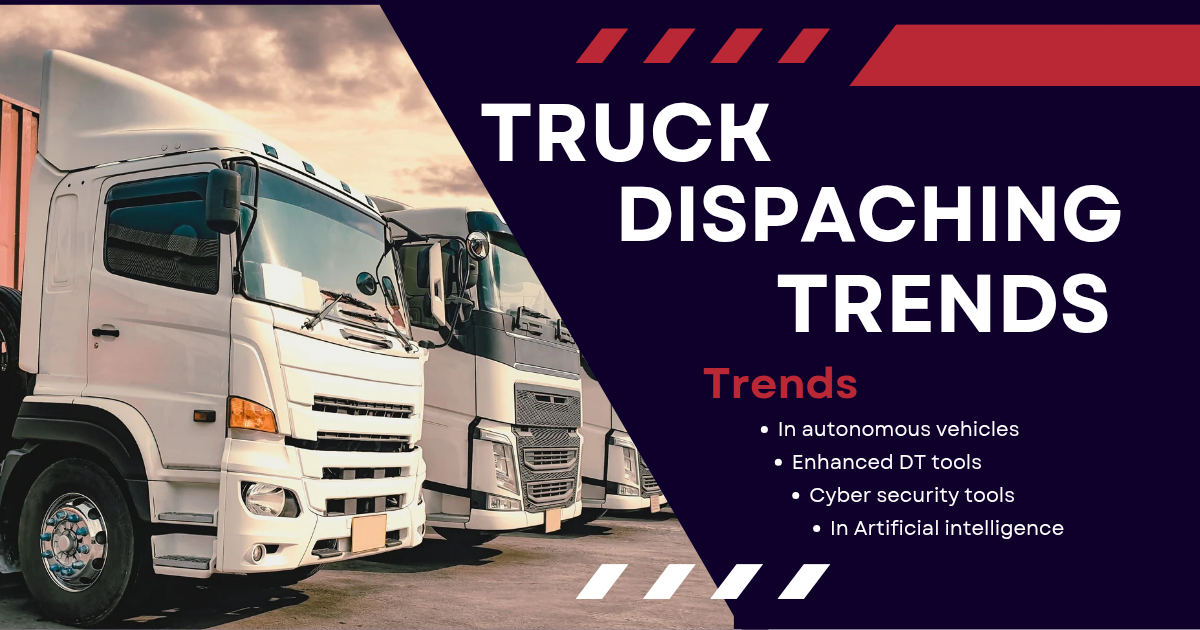
Table of Contents
The Beginning Point
The core of this development is the truck dispatching ability. It is the trends in truck dispatching that shape fleet management, delivery speed, and cost control as well as item delivery timing. Driven mostly by improvements in digital technology, automation, and data analytics, the fields of logistics and transportation are now undergoing a period of significant transformation.
Looking ahead, the patterns in truck dispatching that will surface over the next five years will have a major influence on the operations of dispatchers, fleet managers, and logistics companies.
This blog aims to look at forthcoming truck dispatching trends projected to boost operational efficiency, save expenses, and raise customer satisfaction by improving operational effectiveness.
1. Combining of Artificial Intelligence (AI) with Machine Learning

Regarding truck dispatching, one of the most significant changes is the integration of artificial intelligence and machine learning to improve decision-making in real time. These tools can examine vast amounts of data, identify trends, and offer intelligent recommendations, thereby helping dispatchers in making better-educated decisions about routing. It is the trends in truck dispatching that shape fleet management and delivery speed.
Principal Benefits:
- Predictive analytics for traffic, weather, and road conditions
- Route optimization depending on historical and real-time data
- Fuel economy and delivery delays eliminated
- Improved load assignment efficiency helps to reduce deadhead mileage
Artificial intelligence-powered dispatch systems will lower human error, increase schedule accuracy, and maximize resource use—all of which are vital markers of cost-effectiveness and sustainability.
2. The Use of Semi- and Autonomous Cars
As new advancements in autonomous driving technology keep developing, their impact on dispatching will be major. Even if completely driverless trucks may not become the norm over the next five years, semi-autonomous technologies and driver-assist features will progressively improve fleet operations. It is the trends in truck dispatching that shape fleet management and delivery speed.
Use in the Near Future:
- Human-driven and autonomous cars coordinate automatically
- Communication in real time between them and dispatch systems
- Scheduling depends on vehicle availability and artificial intelligence-made forecasts
The new trends in truck dispatching depend critically on dispatchers learning how to coordinate human and automated drivers, hence they will have to adapt.
3. Spread of Telematics Tools and Real-Time Tracking Capacities
While real-time tracking and telematics are currently indispensible, their future potential is huge. Telematics, GPS, and Internet of Things sensors will cooperate in a seamless manner over the next five years to give dispatchers unmatched access to the health of cars, driver behavior, and cargo conditions. It is the trends in truck dispatching that shape fleet management and delivery speed.
Forthcoming Developments in Technology:
- Blockchain technologies’ integration guarantees that tracking records cannot be changed
- Tracking temperature, humidity, and cargo conditions with sophisticated sensors
- Dynamic estimated time of arrival updates created from real-time data
Regarding dispatching activities, this kind of openness and responsiveness will finally become the standard and enable proactive decision-making instead of reactive ones.
4. Cloud Platforms for Internet-Based Dispersion
One of the developing trends in the truck dispatching sector nowadays is the shift to cloud-hosted dispatching platforms. These solutions help businesses to properly expand their activities, increase their capacity for teamwork, and guarantee access from anywhere. It is the trends in truck dispatching that shape fleet management and delivery speed.
Features of Cloud-Based Systems hosting:
- Integration with other tools including accounting systems, corporate resource planning (ERP), and customer relationship management (CRM)
- Secure data backups and faster updates
- Multi-location coordination across depots and terminals
Dispatchers may better control fleets by being able to get data in real time and have flawless communication all through the supply chain.
5. Automated Load Matching and Digital Goods Markets
Online freight markets are revolutionizing the process of matching available trucks with loads. By means of smart algorithms, these systems are able to efficiently link carriers and shippers, therefore reducing downtime and maximizing profitability. It is the trends in truck dispatching that shape fleet management and delivery speed.
Methods of Use:
- Instant load-booking informed by artificial intelligence recommendations
- Clear pricing and automatic payment processing
- Direct access to shipment possibilities free from the necessity of a broker
Automated load matching will help to lower the manual duties that dispatchers are needed to complete and so contribute to an overall increase in fleet efficiency, so supporting more efficient trends in truck dispatching.
6. Approaches of Decision-Making Motivated by Data
Big data will define the game in five years as well. For dispatchers and fleet managers to help with decision-making, dashboards and analytics will become ever more crucial. It is the trends in truck dispatching that shape fleet management and delivery speed.
Data Access-Made Possible Insights:
- Examining driver performance and delivery time
- Identifying profitable paths and load kinds
- Approximating fuel usage and maintenance needs
By means of data as a strategic tool, dispatching will evolve from a reactive profession into a predictive, insight-driven activity in the future.
7. Sustainability and Green Dispatching
In terms of logistics planning, environmental elements are starting to take front stage. The implementation of emission regulations by both governments and businesses is causing consumers to demand more ecologically friendly delivery methods. It is the trends in truck dispatching that shape fleet management and delivery speed.
Method of Environmentally Responsible Shipping:
- Giving electric and hybrid trucks top priority
- Routing that results in the lowest possible emissions and maximizes fuel economy
- Real-time tracking to reduce idling and excessive use
Goals of sustainability will affect every step of the dispatching process. Aligning companies with environmentally friendly truck dispatching trends is one approach they can get a competitive advantage.
8. Enhanced Driver Communication Tools (DT)
Communication solutions are under development to help to promote more friendly contacts between dispatchers and drivers. Future enhanced communication methods that do not depend on hands as well as real-time feedback and message via applications will be evident. It is the trends in truck dispatching that shape fleet management and delivery speed.
Benefits:
- Less instances of miscommunication and delivery delays
- Higher degrees of driver satisfaction and retention
- Opportunity to get updates and alerts via voice control
A motorist who is linked and informed produces more. Effective communication between drivers and dispersion teams will be essential to guarantee that operations are ready for the future.
9. Mobile-First Dispatching Systems
Given the workforce is growing more mobile and tech-savvy, dispatching systems must be interoperable with mobile devices. Through their mobile devices—cellphones and tablets—dispatchers and drivers will be able to access end-to-end capabilities. It is the trends in truck dispatching that shape fleet management and delivery speed.
Characteristics Anticipated:
- Notifications issued to mobile devices in the event of route changes, delays, or emergencies
- Instantaneous task assignment and status updates
- Real-time tracking of the fleet from mobile devices
Using mobile-first solutions will allow smaller dispatch teams to operate with the same degree of efficiency as bigger companies, therefore aligning with modern trends in truck dispatching.
10. Cybersecurity and Compliance Automated Tools
Dispatch systems are being more vulnerable to cyberattacks since they are getting more computerized. Main areas of focus will be on personal data protection and following safety guidelines. It is the trends in truck dispatching that shape fleet management and delivery speed.
What Is Coming Soon?
- Artificial intelligence technologies for regulatory risk assessment
- Improved cybersecurity policies including multi-factor authentication
- Automatic logging and reporting of hours-of-service (HOS)
Future dispatching systems will not only streamline processes but also ensure that fleets keep their security and adhere with rules, therefore maintaining both assets and reputation.
11. Integrated Payment and Invoicing Systems
Another trend that is becoming more and more popular is the direct integration of invoicing and payment systems straight into their dispatch systems. Automating these procedures helps save time and lowers the possibility of human error. It is the trends in truck dispatching that shape fleet management and delivery speed.
Forecasts Regarding Capacity:
- One-click invoicing for completed deliveries
- Fast digital payments and receipts
- Open payment tracking for consumers as well as drivers
The streamlining of financial processes will allow dispatchers to concentrate on operations rather than back-office tasks.
12. Growing Integration Count of Third-Party Logistics (3PL) Solutions
To reach their quick and affordable scaling targets, many businesses are looking to outside logistics (3PL) vendors. Dispatching systems must show support if we want to enable seamless coordination with these outside organizations.
Integration Attributes and Purposes:
- Common dashboards and communication tools
- Interoperability with many platforms for real-time data transmission
- Unified performance reporting
Businesses will be able to scale without compromising control or efficiency by better connecting with third-party logistics (3PL) providers.
Final Notes
Over the next five years, automation, artificial intelligence, and environmentally friendly methods will bring in a new phase of logistics. As the terrain of technology keeps changing, trends in truck dispatching will be expected more. Businesses able to keep ahead of the developments in truck dispatching—which include artificial intelligence, mobile platforms, and green logistics—will be able to set themselves apart in a very competitive industry.
Adopting these new trends would not only boost operational efficiency but also customer service, driver satisfaction, and financial outcomes improvement. Now is the moment to invest in next-generation dispatching solutions if logistics companies wish to be ready for a future smarter, faster, and more ecologically friendly.
Want to know about “Easy ways to protect your computer from viruses and malware“

